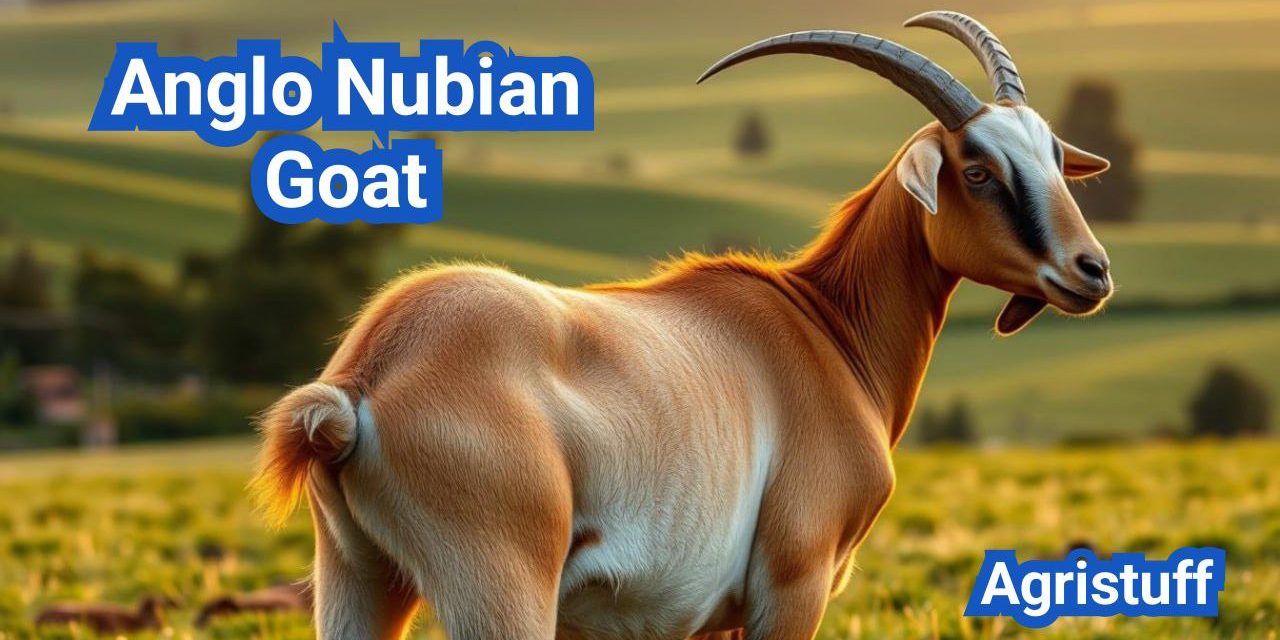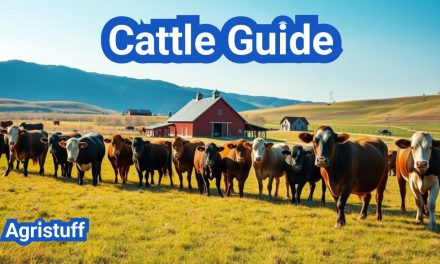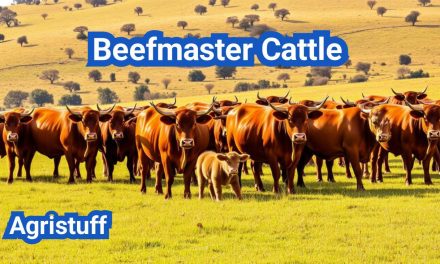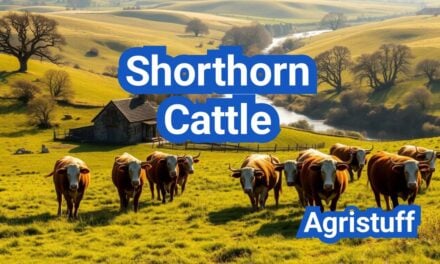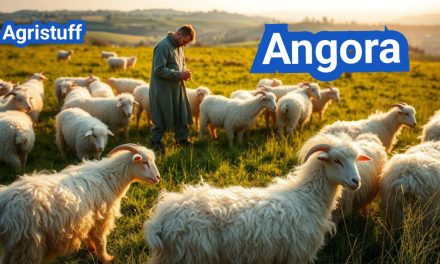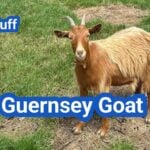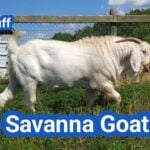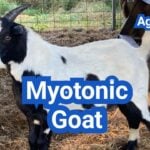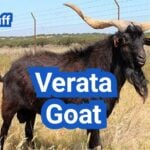The Anglo Nubian Goat is a distinctive breed known for its versatility and high-quality milk production. Originating from cross-breeding between British goats and exotic breeds, this dual-purpose dairy breed has gained popularity worldwide.
Characterized by their long, pendulous ears, Anglo Nubian Goats are not only prized for their milk but also for their robust build and friendly temperament. With a mature weight that can vary, they are a significant addition to any livestock operation focused on dairy production.
Key Takeaways
- Originated from cross-breeding between British and exotic breeds.
- Known for high-quality milk production.
- Characterized by long, pendulous ears.
- Robust build and friendly temperament.
- Significant in dairy production.
The Anglo Nubian Goat: A Breed Overview
The Anglo Nubian breed stands out in the world of goat dairy farming due to its unique features and high productivity. As a dual-purpose goat, it is valued for both its milk production and its hardiness.
What Makes Anglo Nubians Unique
Anglo Nubian goats are known for their friendly temperament and high milk production. Their distinctive appearance, characterized by long ears and a “Roman nose,” sets them apart from other breeds.
- Friendly Temperament: They are known for their gentle nature, making them easy to handle.
- High Milk Production: Anglo Nubians are prolific milk producers, with their milk being rich in butterfat.
- Distinctive Appearance: Their long, pendulous ears and “Roman nose” are breed hallmarks.
Position Among Dual-Purpose Goat Breeds
Among dual-purpose goat breeds, the Anglo Nubian holds a significant position due to its versatility and productivity. It is particularly valued for its ability to thrive in various environments.
- Their hardiness and adaptability make them suitable for a range of farming conditions.
- Their milk is not only abundant but also of high quality, rich in nutrients.
- They are a popular choice among dairy farmers due to their friendly nature and ease of management.
In summary, the Anglo Nubian goat breed is a standout choice for dairy farmers and homesteaders alike, offering a unique combination of high milk production, hardiness, and a friendly temperament.
The Rich History and Origin of Anglo Nubian Goats
With roots in both British dairy farming and Middle Eastern heritages, the Anglo Nubian goat has a unique origin story. The breed was developed in the late 19th century in the United Kingdom.
British and Middle Eastern Heritage
The Anglo Nubian breed was created by crossing native British dairy goats with exotic breeds from the Middle East, Africa, and India. This cross-breeding introduced desirable traits such as high milk production, rich milk quality, and heat tolerance.
The infusion of Middle Eastern breeds, known for their robust nature and milk-producing capabilities, significantly enhanced the genetic pool of the Anglo Nubian. This blend of heritages resulted in a hardy and productive dairy goat breed.
Development of the Modern Anglo Nubian
The development of the modern Anglo Nubian involved careful selection and breeding practices. Breeders focused on enhancing milk production, improving milk quality, and maintaining the breed’s hardiness.
By the early 20th century, the Anglo Nubian had become a distinct breed with a reputation for its rich milk and robust constitution. The breed’s development was marked by a commitment to creating a dual-purpose goat suitable for both milk and meat production.
Introduction to the United States
The Anglo Nubian breed was introduced to the United States in the early 20th century, where it gained popularity among dairy goat breeders. American breeders further refined the breed, focusing on its dairy potential and adaptability to local farming conditions.
Today, the Anglo Nubian is recognized as a valuable dairy breed in the United States, known for its high milk production and rich milk quality. The breed’s history is a testament to the successful blending of international genetic resources and careful breeding practices.
Physical Characteristics of Anglo Nubian Goats

Anglo Nubian goats are easily recognizable due to their unique physical characteristics. One of the breed’s most distinguishing features is its appearance, which sets it apart from other goat breeds.
Distinctive Appearance Features
The Anglo Nubian goat is known for its long, pendulous ears and a distinctive “Roman nose”, which is a convex profile. These features contribute to the breed’s striking appearance and are highly valued by breeders.
The breed’s overall physique is sturdy, with a muscular build that indicates its dual-purpose nature, suitable for both milk production and meat.
Color Variations and Patterns
Anglo Nubian goats exhibit a wide range of color variations, including various shades of brown, black, and red. They can be solid-colored or display complex patterns, making each individual unique.
The breed’s coat can vary in length and texture, but it generally provides adequate protection against various environmental conditions.
The Unique “Roman Nose” and Pendulous Ears
The “Roman nose” is a hallmark of the Anglo Nubian breed, characterized by a convex nasal profile. This feature, combined with their long, pendulous ears, gives the breed a distinctive look that is easily recognizable.
These physical characteristics not only contribute to the breed’s aesthetic appeal but also play a role in its popularity among goat enthusiasts.
Size and Weight Specifications
When considering an Anglo Nubian goat for your farm, understanding its size and weight is crucial. The breed is known for its substantial size, which is one of its attractive features for dairy farming.
Average Weight Range for Bucks and Does
Adult Anglo Nubian does typically weigh between 60-70 kg (132-154 lbs), while bucks can weigh up to 100 kg (220 lbs). This significant weight range is a testament to the breed’s robustness and its potential for high milk production.
Growth Patterns from Kid to Adult
Anglo Nubian kids are born with a relatively low weight, typically around 2.5-3.5 kg (5.5-7.7 lbs). However, they grow rapidly, reaching maturity within the first year. Proper nutrition during this period is crucial for optimal growth. By understanding the growth patterns, farmers can better manage the health and development of their goats.
Miniature Anglo Nubian Varieties
While the standard Anglo Nubian is well-known for its size, there are also miniature varieties. These smaller goats are bred to retain the characteristics of the standard breed but in a more compact form. They are ideal for smaller farms or for those looking to diversify their herd with a variety of sizes.
The size and weight specifications of Anglo Nubian goats, including the miniature varieties, make them a versatile choice for farmers. Whether you’re looking for a robust dairy goat or a smaller, more manageable alternative, the Anglo Nubian breed offers options.
How to Start an Anglo Nubian Goat Farm

For those looking to start an Anglo Nubian goat farm, the first step involves acquiring the right equipment and knowledge. Anglo Nubian goats are known for their rich milk and friendly disposition, making them a popular choice among dairy farmers.
Essential Equipment and Setup
The initial setup for an Anglo Nubian goat farm includes fencing, housing, and feeding equipment. Proper fencing is crucial to keep the goats secure and prevent predators from entering the farm. The fencing should be at least 5 feet tall to prevent jumping.
- Sturdy fencing materials
- Comfortable housing with adequate ventilation
- Feeding troughs and clean water supply systems
Space Requirements and Housing
Anglo Nubian goats require sufficient space to roam and exercise. A minimum of 1/4 acre per goat is recommended for grazing and movement. Housing should be dry, well-ventilated, and protected from extreme weather conditions.
The housing area should be designed to accommodate the goats comfortably, with enough room for feeding, resting, and kidding. It’s also essential to have separate areas for sick or injured goats to prevent the spread of disease.
Initial Investment Considerations
The initial investment for starting an Anglo Nubian goat farm includes the cost of purchasing the goats, fencing, housing, and equipment. The cost can vary widely depending on the size of the farm and the number of goats.
| Item | Estimated Cost |
|---|---|
| Anglo Nubian Goats (per head) | $200-$500 |
| Fencing (per acre) | $1,000-$3,000 |
| Housing and Equipment | $2,000-$5,000 |
It’s crucial to create a detailed budget that includes these costs, as well as ongoing expenses such as feed, veterinary care, and supplies. Starting a goat farm requires a significant initial investment, but with proper planning, it can be a rewarding venture.
Complete Feeding and Nutrition Guide
Understanding the nutritional needs of Anglo Nubian goats is key to their overall well-being and milk production. A well-balanced diet is essential for maintaining their health, ensuring they remain productive, and supporting their growth.
Daily Dietary Requirements
Anglo Nubian goats require a diet rich in nutrients to support their high milk production and overall health. Their daily dietary needs include a mix of high-quality hay, grains, and minerals. A general guideline is to provide 1-2% of their body weight in dry matter per day.
- High-quality hay should make up the bulk of their diet.
- Grains can be added to support milk production and energy needs.
- Minerals and vitamins are crucial for maintaining overall health.
Supplementation for Optimal Health
While a balanced diet covers most nutritional needs, supplementation can be necessary to ensure optimal health. Vitamins and minerals such as calcium, phosphorus, and vitamin D are critical for bone health and milk production.
- Provide free-choice minerals specifically formulated for goats.
- Consider adding supplements during periods of high demand, such as late pregnancy or peak lactation.
- Consult with a veterinarian to determine the best supplementation plan.
Water and Mineral Needs
Access to clean water is vital for Anglo Nubian goats. They require adequate water intake to support their milk production and overall health. Mineral needs should also be met through a combination of their diet and supplementation.
| Nutrient | Importance | Sources |
|---|---|---|
| Water | Essential for hydration and milk production | Clean water sources |
| Calcium | Critical for bone health and milk production | High-quality hay, mineral supplements |
| Phosphorus | Important for bone health and energy metabolism | Grains, mineral supplements |
Maximizing Anglo Nubian Goat Milk Production

Maximizing milk production in Anglo Nubian goats requires a comprehensive understanding of their production cycles and nutritional needs. Anglo Nubian goats are known for their high milk yield, with a rich milk composition that is ideal for dairy products.
Expected Yield and Production Cycles
The average milk yield for Anglo Nubian goats can range from 1,000 to 1,200 pounds per year, with a lactation period typically lasting around 305 days. Understanding the production cycles is crucial for managing the dairy operation effectively.
Key factors influencing milk yield include genetics, nutrition, and overall health. A well-balanced diet that includes high-quality forage and appropriate supplementation is essential for maintaining optimal milk production.
Milk Composition and Quality
The milk of Anglo Nubian goats is characterized by a butterfat content of around 4-5%, making it suitable for producing a variety of dairy products, including cheese and butter.
The quality of the milk is influenced by factors such as diet, health, and milking practices. Regular testing and monitoring of milk quality are vital for ensuring the production of high-quality dairy products.
Factors Affecting Production Levels
Several factors can impact milk production levels in Anglo Nubian goats, including nutritional deficiencies, health issues, and inadequate milking practices.
- Nutritional deficiencies can significantly reduce milk yield.
- Health issues, such as mastitis, can affect milk quality and quantity.
- Inadequate milking practices can lead to reduced milk production and quality.
By addressing these factors and implementing effective management practices, dairy farmers can maximize milk production in their Anglo Nubian goat herds.
Essential Health Management Protocol

A well-structured health management protocol is essential for the overall well-being of Anglo Nubian goats. Effective health management ensures that these goats remain healthy and productive, which is crucial for dairy farming.
Preventative Care Schedule
Regular health checks, vaccinations, and parasite control are critical components of a preventative care schedule for Anglo Nubian goats. Vaccinations should be administered according to a schedule recommended by a veterinarian, taking into account the specific diseases prevalent in your area.
“Prevention is better than cure,” as the saying goes. This is particularly true for goat health. Regular vaccinations can prevent diseases such as Caseous lymphadenitis and Clostridium perfringens type D. A parasite control program should also be implemented to protect against internal parasites.
- Conduct regular fecal exams to monitor for internal parasites.
- Administer deworming medications as necessary, based on fecal exam results.
- Implement a rotational grazing program to reduce parasite loads on pastures.
Recognizing Signs of Illness
Early detection of illness is crucial for effective treatment. Goat owners should be aware of the common signs of illness in Anglo Nubian goats, including changes in appetite, lethargy, and abnormal feces or urine. Monitoring goats daily can help identify health issues early, when they are more easily treatable.
“The ability to recognize the signs of illness in goats is a skill that every goat owner should possess. It can make the difference between life and death for your animals.”
Working with Veterinarians
Developing a relationship with a veterinarian experienced in caring for goats is invaluable. A veterinarian can provide guidance on health management protocols, help diagnose illnesses, and recommend appropriate treatments. Regular consultations can also help prevent health issues through advice on nutrition, parasite control, and vaccination programs.
By following a comprehensive health management protocol, Anglo Nubian goat owners can ensure the health and productivity of their animals. This includes preventative care, recognizing signs of illness, and working closely with veterinarians.
Step-by-Step Breeding Guide for Anglo Nubian Goats

The process of breeding Anglo Nubian goats involves a series of steps that, when followed correctly, can lead to a healthy and thriving herd. Breeding these goats requires a comprehensive understanding of their reproductive characteristics and needs.
Selecting Quality Breeding Stock
Selecting the right breeding stock is crucial for the success of your Anglo Nubian goat breeding program. Quality breeding stock should exhibit the breed’s characteristic features, such as the distinctive “Roman nose” and pendulous ears. It’s essential to choose animals with good genetic traits, robust health, and a temperament suitable for your farm’s environment.
When evaluating potential breeding stock, consider factors such as:
- Genetic diversity to avoid inbreeding
- Health records, including vaccination history and parasite resistance
- Production records, such as milk yield for does
- Conformation and physical characteristics that align with breed standards
| Characteristic | Ideal Trait | Importance Level |
|---|---|---|
| Genetic Diversity | High diversity | High |
| Health | Robust, disease-resistant | High |
| Milk Production | High yield, good quality | Medium |
| Temperament | Docile, easy to handle | Medium |
Breeding Season Considerations
The breeding season for Anglo Nubian goats can vary depending on your location and climate. Generally, the breeding season starts in late summer to early fall. It’s crucial to plan the breeding season to ensure that kidding occurs at a time that is favorable for the kids’ survival and growth.
Consider the following factors when planning your breeding season:
- Climate and weather conditions
- Availability of feed and pasture
- Management and labor resources
- Market demand for kids or breeding stock
Pregnancy and Kidding Management
Once breeding is successful, managing the pregnancy and kidding process is critical. Ensure that pregnant does receive proper nutrition and care to support their health and the development of the kids.
Key considerations during pregnancy and kidding include:
- Nutritional supplementation as needed
- Monitoring for signs of impending kidding
- Assistance during kidding if necessary
- Post-kidding care for both the doe and kids
By carefully managing these aspects, you can improve the outcomes of your breeding program and maintain a healthy, productive herd.
Raising Healthy Anglo Nubian Kids

Anglo Nubian kids are born with a lot of potential, and with the right care and socialization, they can grow into healthy, productive goats. Providing proper care and nutrition is crucial for the health and development of young Anglo-Nubian kids.
Birth to Weaning Care
The initial months of a kid’s life are critical. Ensuring they receive adequate colostrum and nutrition is vital. “Colostrum is the first form of milk produced by the mammary glands of female mammals immediately following delivery of the newborn,” as noted by agricultural experts. It is rich in antibodies that help build the kid’s immune system.
From birth to weaning, kids should be monitored closely for signs of illness or distress. Regular checks on their weight and overall health can help identify any issues early on.
Socialization and Training
Socialization is a key aspect of raising healthy Anglo Nubian kids. It involves handling them gently and regularly from an early age to make them more docile and easier to manage as adults. Training should start early, teaching them to lead and halter train, which makes future veterinary care and handling much simpler.
As emphasized by experienced breeders, “Early socialization and gentle handling are crucial for developing well-behaved and manageable goats.”
Health Protocols for Young Goats
Implementing a robust health protocol is essential for young goats. This includes vaccinations, parasite control, and regular health checks. Kids should be vaccinated against common diseases, and a schedule for parasite control should be established based on veterinary advice.
- Regular vaccinations against diseases such as CDT (Clostridium perfringens type C and D and Tetanus toxoid).
- Parasite control measures, including deworming, should be implemented based on veterinary guidance.
- Monitoring for signs of illness and addressing any health issues promptly.
By following these guidelines, farmers can ensure their Anglo Nubian kids grow into healthy, productive adults, contributing to a successful and sustainable goat farming operation.
Anglo Nubian Goat Care Through the Seasons

As the seasons change, so do the needs of your Anglo Nubian goats, necessitating adaptable care strategies. Ensuring the health and productivity of these dual-purpose dairy goats involves understanding and responding to the challenges posed by different weather conditions.
Winter Care Requirements
During the winter months, Anglo Nubian goats require extra care to maintain their health and milk production. Providing adequate shelter is crucial to protect them from harsh weather conditions. The shelter should be well-ventilated, dry, and draft-free. Ensuring access to unfrozen water and increasing their nutritional intake can help them stay warm and maintain their body condition.
It’s also essential to monitor their health closely during this period, as cold stress can lead to various health issues. Regular checks for signs of illness and maintaining a clean living environment are vital components of winter care.
Summer Heat Management
Anglo Nubian goats are susceptible to heat stress during the summer months due to their origins and physical characteristics. Managing heat stress involves providing adequate shade, ensuring access to plenty of cool water, and adjusting their feeding schedule to avoid the hottest parts of the day.
“Heat stress can significantly impact the milk production and overall health of Anglo Nubian goats. Implementing cooling measures such as fans or misting systems can help mitigate these effects.”
Monitoring the goats’ response to the heat and making necessary adjustments to their care routine is crucial for maintaining their well-being.
Spring and Fall Transition Periods
The spring and fall seasons bring their own set of challenges and opportunities for Anglo Nubian goat care. During these transition periods, it’s essential to gradually adjust their diet to reflect the changing availability of pasture and nutritional needs.
- Spring: Introduce new pasture gradually to prevent digestive issues.
- Fall: Prepare for the upcoming winter by ensuring they are in good body condition.
These periods also offer a chance to implement preventative health measures, such as vaccinations and parasite control, to keep the herd healthy.
Creating Value from Anglo Nubian Milk

Anglo Nubian milk stands out for its rich composition, making it perfect for cheese-making and other dairy applications. The high butterfat content in Anglo Nubian milk is particularly beneficial for producing rich and creamy dairy products.
Cheese-Making with Anglo Nubian Milk
The unique characteristics of Anglo Nubian milk make it an excellent choice for cheese production. The high fat content contributes to a richer flavor and creamier texture in cheeses such as cheddar, feta, and ricotta.
- Cheddar: A popular cheese that benefits from the rich flavor of Anglo Nubian milk.
- Feta: The tanginess of feta is enhanced by the butterfat content in Anglo Nubian milk.
- Ricotta: Used in various culinary applications, ricotta made from Anglo Nubian milk is exceptionally creamy.
Other Dairy Products and Applications
Beyond cheese-making, Anglo Nubian milk is versatile and can be used to create a variety of other dairy products. These include:
- Yogurt: The richness of Anglo Nubian milk makes for a delicious and healthy yogurt.
- Butter: The high butterfat content is ideal for producing high-quality butter.
- Ice Cream: Anglo Nubian milk can be used to make rich and creamy ice cream.
Nutritional Benefits of Anglo Nubian Milk
Anglo Nubian milk is not only valuable for its dairy applications but also for its nutritional benefits. It is rich in:
- Protein: Essential for muscle growth and repair.
- Calcium: Crucial for bone health.
- Vitamins and Minerals: Anglo Nubian milk contains a range of vitamins and minerals beneficial for overall health.
The nutritional profile of Anglo Nubian milk makes it a valuable resource for both dairy production and direct consumption.
Managing Anglo Nubian Goats with Horns

The presence of horns in Anglo Nubian goats can be both beneficial and challenging for farmers. While some breeders choose to disbud their goats, others prefer to keep their animals horned. This decision involves considering several factors, including the pros and cons of keeping horned goats, disbudding practices, and necessary safety measures.
Pros and Cons of Keeping Horned Goats
Keeping horned goats has its advantages and disadvantages. On the one hand, horns can serve as a natural defense mechanism against predators, potentially reducing the need for additional security measures. Horned goats may also establish a pecking order more effectively, reducing conflicts within the herd.
On the other hand, horned goats can pose a risk to other animals and humans if not managed properly. The horns can cause injury during fights or when handled improperly. Additionally, horned goats may require more careful handling and housing to prevent accidents.
| Advantages | Disadvantages |
|---|---|
| Natural defense against predators | Risk of injury to humans and other animals |
| Establishes pecking order effectively | Requires careful handling and housing |
Disbudding Practices and Considerations
Disbudding is the process of removing the horn buds from young goats to prevent the growth of horns. This practice is often performed to reduce the risk of injury and simplify handling. However, it is a controversial topic among goat breeders, with some arguing it is necessary for safety and others believing it is inhumane or unnecessary.
When considering disbudding, it is essential to weigh the potential benefits against the risks and consider alternative methods of managing horned goats. The decision should be based on the specific needs and circumstances of the farm and the welfare of the animals.
Safety Measures for Horned Herds
For farmers who choose to keep their Anglo Nubian goats horned, implementing safety measures is crucial. This includes providing adequate space and appropriate housing to reduce the risk of injury. Handling horned goats requires care and caution, and farmers should be trained in safe handling practices.
Additionally, ensuring that the herd is well-socialized and that the goats are not overly aggressive can help minimize conflicts. Regular monitoring and maintenance of the goats’ living conditions are also vital for preventing accidents.
- Provide adequate space and appropriate housing
- Train handlers in safe handling practices
- Monitor herd behavior and socialization
- Maintain living conditions regularly
Market Opportunities for Anglo Nubian Goat Farmers in the USA
With their unique characteristics, Anglo Nubian goats offer various market opportunities for farmers across the USA. The growing demand for high-quality dairy products and the breed’s adaptability make them an attractive choice for farmers looking to diversify their operations.
Dairy Market Potential
The dairy market is a significant opportunity for Anglo Nubian goat farmers. Anglo Nubian milk is rich in butterfat, making it ideal for producing high-quality cheese, butter, and other dairy products. The demand for these products is increasing, driven by consumers looking for unique and artisanal foods.
Farmers can capitalize on this trend by developing a niche market for their dairy products. This could involve selling directly to consumers through farmers’ markets, online platforms, or through local retailers.
Breeding Stock Sales
Another lucrative market for Anglo Nubian goat farmers is the sale of breeding stock. The breed’s hardiness, milk production capabilities, and distinctive appearance make it popular among other farmers looking to improve or start their dairy goat operations.
To succeed in this market, farmers need to focus on developing high-quality breeding stock. This involves careful selection and breeding practices to ensure that their goats have desirable traits.
Value-Added Products
Creating value-added products is a further opportunity for Anglo Nubian goat farmers to increase their revenue. This can include a range of products such as cheese, soap, lotion, and other items made from the milk or milk by-products.
Developing a brand around these products can help farmers differentiate themselves in the market and attract premium prices. It’s essential to ensure that any value-added products comply with local regulations and are marketed effectively to the target audience.
Implementing Sustainable Farming Practices with Anglo Nubians
Implementing sustainable methods in Anglo Nubian goat farming not only benefits the environment but also enhances the overall health of the herd. Sustainable farming practices are essential for maintaining the long-term health of the land and the goat herd.
Environmental Impact Considerations
Anglo Nubian goat farming, like other agricultural practices, has an environmental impact that needs to be managed sustainably. This includes maintaining soil quality, conserving water, and minimizing waste.
- Soil conservation through rotational grazing
- Water management strategies to reduce waste
- Efficient waste management systems
By adopting these practices, farmers can significantly reduce the ecological footprint of their operations.
Integration with Other Farming Systems
Integrating Anglo Nubian goat farming with other farming systems can enhance overall farm productivity and sustainability. This can involve:
| Integration Method | Benefits |
|---|---|
| Agroforestry | Diverse ecosystem, improved soil health |
| Crop rotation with goat grazing | Improved soil fertility, reduced pests and diseases |
| Manure used as fertilizer | Reduced chemical fertilizer use, improved soil structure |
Long-term Sustainability Strategies
To ensure long-term sustainability, Anglo Nubian goat farmers should adopt strategies that promote ecological balance and economic viability. This includes:
- Regular monitoring of environmental impact
- Continuous improvement of farming practices
- Diversification of farm products and income streams
Long-term planning and adaptability are key to maintaining a sustainable and productive Anglo Nubian goat farm.
Is the Anglo Nubian Right for Your Farm?
The Anglo Nubian Goat is a versatile breed that can thrive in various farming systems. To determine if this breed is suitable for your farm, consider your climate, resources, and farming goals. The Anglo Nubian’s adaptability, milk production, and unique characteristics make it an attractive choice for many farmers.
When evaluating farm suitability, consider the breed’s requirements and your ability to provide the necessary care and resources. The Anglo Nubian Goat’s hardiness and resistance to certain diseases make it a viable option for farmers in different regions.
Ultimately, the decision to raise Anglo Nubian Goats depends on your specific needs and goals. By understanding the breed’s characteristics and requirements, you can make an informed decision about whether the Anglo Nubian is the right choice for your farm.
FAQ
What is the origin of the Anglo Nubian Goat breed?
The Anglo Nubian Goat breed originated from crossing native British goats with bucks from the Middle East and North Africa, resulting in a unique and versatile dual-purpose dairy breed.
What are the distinctive physical characteristics of Anglo Nubian Goats?
Anglo Nubian Goats are known for their long, pendulous ears and a “Roman nose.” They come in a variety of colors and patterns, making them visually distinctive among other goat breeds.
How much milk do Anglo Nubian Goats produce?
Anglo Nubian Goats are recognized for their high milk production. The average milk yield varies, but they are considered one of the better dairy goat breeds, with milk rich in butterfat, making it ideal for cheese-making and other dairy products.
What is the average weight of Anglo Nubian Goats?
Bucks typically weigh between 175-250 pounds, while does weigh between 125-175 pounds. There are also miniature varieties, which are smaller in size.
How do I start an Anglo Nubian Goat farm?
Starting an Anglo Nubian Goat farm requires essential equipment, adequate space for housing, and a significant initial investment. It’s crucial to research and understand the needs of the goats and the local regulations before beginning.
What are the dietary requirements for Anglo Nubian Goats?
Anglo Nubian Goats require a balanced diet that includes high-quality hay, grains, and minerals. They need access to clean water at all times, and their dietary needs may vary depending on their stage of production, such as lactation or growth.
How can I maximize milk production in my Anglo Nubian Goats?
Maximizing milk production involves providing optimal nutrition, ensuring proper health care, and managing stress. Regular milking practices and a comfortable living environment also contribute to higher milk yields.
What health management practices are essential for Anglo Nubian Goats?
Regular preventative care, including vaccinations and parasite control, is vital. Recognizing signs of illness early and working closely with a veterinarian can help maintain the health of the herd.
How do I breed Anglo Nubian Goats?
Breeding involves selecting quality breeding stock, understanding the breeding season, and managing pregnancy and kidding. It’s essential to have a breeding plan and to monitor the health of both the buck and does.
What are the benefits of Anglo Nubian milk?
Anglo Nubian milk is rich in butterfat, making it ideal for cheese-making and other dairy products. It has nutritional benefits, including being a good source of protein, calcium, and vitamins.
Can Anglo Nubian Goats be raised in different climates?
Yes, Anglo Nubian Goats are adaptable to various climates, but they require appropriate care and housing to thrive in extreme weather conditions. Providing shelter and managing their exposure to heat or cold is crucial.
What are the market opportunities for Anglo Nubian Goat farmers?
Market opportunities include selling dairy products, such as cheese and milk, breeding stock, and value-added products. There’s potential in both local and broader markets, depending on the scale and strategy of the farm.
How can I implement sustainable farming practices with Anglo Nubian Goats?
Implementing sustainable practices involves considering the environmental impact, integrating goats with other farming systems, and adopting long-term sustainability strategies to maintain soil health, biodiversity, and efficient water use.
Conclusion of: Anglo Nubian Goat
Anglo-Nubian goats, often simply called Nubians in the U.S., are one of the most popular goat breeds for dairy and meat production. Known for their long, floppy ears, Roman noses, and high butterfat milk, these goats are a favorite among homesteaders, small farmers, and commercial dairy operations.
This SEO-optimized guide (targeting U.S. readers) covers everything you need to know about Anglo-Nubian goats—from their history and characteristics to care, breeding, and profitability.
1. History & Origin of Anglo-Nubian Goats
The Anglo-Nubian goat originated in 19th-century England by crossing British dairy goats with bucks from Africa, India, and the Middle East (particularly Egyptian Zaraibi and Indian Jamnapari goats)15. These imports contributed to the breed’s heat tolerance, large size, and high milk fat content.
- First imported to the U.S. in 1909, where they became known simply as “Nubians”6.
- Officially recognized as a breed in the U.S. in 19131.
- Named after the Nubian Desert in Sudan, reflecting their African ancestry5.
Why are they popular in the U.S.?
✔ Rich, high-fat milk (ideal for cheese & yogurt)
✔ Dual-purpose (milk & meat)
✔ Friendly, social temperament (great for families)
✔ Heat-tolerant (unlike Swiss dairy breeds)26.
2. Physical Characteristics
Anglo-Nubians are easily recognizable due to their distinctive features:
- Long, pendulous ears (extending past the muzzle)1.
- Roman nose (convex facial profile)5.
- Short, glossy coat (colors: black, tan, red, white, or spotted)6.
- Large size:
- Does: 135–175 lbs, 30+ inches tall1.
- Bucks: 175–310 lbs, 35+ inches tall5.
- Horns: Some are polled (naturally hornless), while others have small, curved horns1.
3. Milk Production & Quality
Nubians are not the highest-producing dairy goats (like Saanens), but their milk is richer and creamier:
- Average yield: ~1/2 to 3/4 gallon per day (5–6 lbs)1.
- Butterfat content: 4–5% (higher than most dairy goats)2.
- Ideal for: Cheese, yogurt, soap, and gourmet dairy products6.
Comparison to Other Dairy Goats
| Breed | Avg. Milk/Day | Butterfat | Best For |
|---|---|---|---|
| Nubian | 0.5–0.75 gal | 4–5% | Cheese, yogurt |
| Saanen | 1–3 gal | 3–4% | High-volume milk |
| Alpine | 1–2 gal | 3.5% | All-purpose dairy |
4. Meat Production
While primarily a dairy breed, Nubians are also good meat producers:
- Fast-growing kids (ready for market sooner)11.
- Lean, flavorful meat (popular in ethnic markets)6.
- Dual-purpose flexibility (ideal for small farms)1.
5. Temperament & Behavior
Nubians are known for their friendly, vocal, and social nature:
✔ Love human interaction (great for petting zoos)10.
✔ Loud & expressive (they “talk” a lot!)6.
✔ Good with kids (both human and goat)1.
❌ Can be stubborn (require patient handling)6.
6. Housing & Fencing Needs
- Shelter: Dry, well-ventilated barn (12–15 sq ft per goat)11.
- Fencing: 4+ feet tall, secure (they love to explore!)3.
- Pasture: Rotational grazing helps prevent parasites11.
7. Feeding & Nutrition
- Hay/Forage (70% of diet) – Alfalfa for lactating does3.
- Grain supplements (for milk production & growth)11.
- Mineral block (prevents deficiencies)3.
- Fresh water (critical for milk yield)11.
8. Breeding & Kidding
- First breeding: 8–12 months old (avoid early breeding)1.
- Gestation: ~150 days (5 months)3.
- Kidding: Usually twins or triplets1.
- Breeding season: Fall (short-day breeders)5.
9. Health & Common Issues
- Hoof care: Trim every 4–6 weeks3.
- Parasites: Rotational grazing & deworming11.
- Mastitis: Watch for udder inflammation3.
- Vaccinations: CDT (clostridial diseases)3.
10. Profitability & Market Demand
Nubians offer multiple income streams:
💰 Raw milk sales ($10–$20/gallon)10.
💰 Artisan cheese & yogurt (premium prices).
💰 Meat (chevon) – Growing demand in ethnic markets11.
💰 Breeding stock (pedigreed Nubians sell for $500–$1,000+)10.
Pros & Cons of Raising Nubians
✅ Pros
✔ High-butterfat milk (great for cheese).
✔ Friendly & easy to handle.
✔ Heat-tolerant (good for Southern U.S.).
✔ Dual-purpose (milk + meat).
❌ Cons
❌ Loud vocalizations (not ideal for urban areas).
❌ Need high-quality feed for best milk production.
❌ Prone to parasites without proper management.
Final Thoughts
Anglo-Nubian goats are an excellent choice for U.S. farmers and homesteaders looking for versatile, high-quality dairy and meat production. Their friendly nature, adaptability, and rich milk make them a profitable and enjoyable breed to raise.
Want to learn more? Check out these resources:
- Oklahoma State University – Anglo-Nubian Goats 2
- American Dairy Goat Association (for breeding standards)
- Storey’s Guide to Raising Dairy Goats 7

